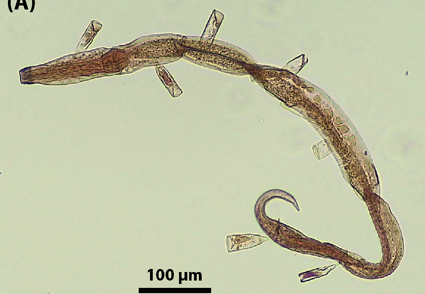Abstract
Three suctorian ciliate species, Paracineta livadiana (Mereschkowsky, 1881), Loricophrya bosporica Sergeeva & Dovgal, 2014 and Acinetopsis lynni Baldrighi et al., 2020 are found as epibionts on meiobenthic nematodes in an oxygen minimum zone of the Arabian Sea. All three species are recorded here for the first time from the Indian Ocean.
References
Ansari, Z.A., Badesab, S., Singh, R. & Kitazato, H. (2017) Meiofaunal distribution across the Oxygen Minimum Zone of continental margin, North East Arabian Sea. International Journal of Marine Science, 7 (7), 59–66. https://doi.org/10.5376/ijms.2017.07.0007
Baldrighi, E., Dovgal, I., Zeppilli, D., Abibulaeva, A., Michelet, C., Michaud, E., Franzo, A., Grassi, E., Cesaroni, L., Guidi, L., Balsamo, M., Sandulli, R. & Semprucci, F. (2020) The cost for biodiversity: records of ciliate–nematode epibiosis with the description of three new suctorian species. Diversity, 12 (6), Article No. 224, 1–25. https://doi.org/10.3390/d12060224
Banse, K., Naqvi, S.W.A., Narvekar, P.V., Postel, J.R. & Jayakumar, D.A. (2014) Oxygen minimum zone of the open Arabian Sea: variability of oxygen and nitrite from daily to decadal timescales. Biogeosciences, 11 (8), 2237–2261. https://doi.org/10.5194/bg-11-2237-2014.
Cook, A.A., Lambshed, P.J.D., Hawkins, L.E., Mitchell, N. & Levin, L.A. (2000) Nematode abundance at the Oxygen minimum zone in the Arabian Sea. Deep Sea Research, Part II, 47, 75–85. https://doi.org/10.1016/S0967-0645(99)00097-1
Dovgal, I.V. (2002) Evolution, phylogeny and classification of Suctorea (Ciliophora). Protistology, 2, 194–270.
Dovgal, I.V. (2013) Ciliates—Ciliophora. Issue 1. Class Suctorea. In: Fauna of Ukraine vol. 36. Naukova dumka, Kiev, pp. 1–267. [in Russian with English summary]
Dovgal, I.V. & Sergeeva, N.G. (2016) Sessile ciliates (Ciliophora) from extreme habitats. Journal of Siberian Federal University, Biology, 9 (4), 385–397. [in Russian with English summary]
Gilly, W.F., Beman, J.M., Litvin, S.Y. & Robison, B.H. (2013) Oceanographic and biological effect of shoaling of the oxygen minimum zone. Annual Review of Marine Science, 5, 393–420. https://doi.org/10.1146/annurev-marine-120710-100849
Ivanova, E., Dovgal, I.V. & Newton, A. (2017) First records of epibiont ciliates (Ciliophora) in methane enriched sediments with species redescriptions. Ecologica Montenegrina, 10, 51–57. https://doi.org/10.37828/em.2017.10.8
Levin, L.A. (2003) Oxygen minimum zone benthos: adaptation and community response to hypoxia. Oceanography and Marine Biology: An Annual Review, 41, 1–15.
Modig, H. & Olafsson, E. (1998) Responses of Baltic benthic invertebrates to hypoxic events. Journal of Experimental Marine Biology and Ecology, 229, 133–148. https://doi.org/10.1016/S0022-0981(98)00043-4
Murrell, M.C. & Fleeger, J.W. (1989) Meiofauna abundance on the Gulf of Mexico continental shelf affected by hypoxia. Continental Shelf Research, 9, 1049–1062
Naqvi, S.W. (2006) Oxygen deficiency in the north Indian Ocean. Gayana, Concepción, 70, 53–58. https://doi.org/10.4067/S0717-65382006000300011
Paulmier, A. & Ruiz-Pino, D. (2009) Oxygen minimum zones (OMZs) in the modern ocean. Progress in Oceanography, 80 (3–4), 113–128. https://doi.org/10.1016/j.pocean.2008.08.001
Root, F.M. (1922) A new suctorian from Woods Hole. Transactions of the American Microscopical Society, 41 (2), 77– 81. https://doi.org/10.2307/3221897
Sautya, S., Gaikwad, S., Khokher, S., Pradhan, U.K., Chatterjee, S., Choudhury, S., Sahu, B. & Attri, S. (2021) Distribution pattern of the Benthic Meiofaunal Community Along the Depth Gradient of the Western Indian Continental Margin, Including the OMZ and Abyssal Plain. Frontiers in Marine Science, 8, 671444. https://doi.org/10.3389/fmars.2021.671444
Sergeeva, N.G. & Zaika, V.E. (2013) The Black Sea meiobenthos in permanently hypoxic habitat. Acta Zoologica Academiae Scientiarum Hungaricae, 65,139–150.
Sergeeva, N.G. & Dovgal, I. (2014) First finding of epibiont peritrich and suctorian ciliates (Ciliophora) on oligochaetes and harpacticoid copepods from the deep-water hypoxic/anoxic conditions of the Black Sea. Ecologica Montenegrina, 1, 49–54. https://doi.org/10.37828/em.2014.1.7
Sergeeva, N.G. & Dovgal, I. (2016) Loricophrya bosporica n. sp. (Ciliophora, Suctorea) epibiont of Desmoscolex cf. minutus (Nematoda, Desmoscolecida) from oxic/anoxic boundary of the Black Sea Istanbul Strait’s outlet area. Zootaxa, 4061 (5), 596–600. https://doi.org/10.11646/zootaxa.4061.5.9
Van Bennekom, A.J. & Hiehle, M.A. (1994) CTD operations and calibrations during legs D1, D2 and D3 of the Netherlands Indian Ocean Programme. In: Van der Linden, W.J.M. & Van der Weijden, C.H. (Eds.), Geological Study of the Arabian Sea. Netherlands Geosciences Foundation, The Hague, pp. 37–66.
Veit-Köhler, G., Guilini K., Peeken, I., Quillfeldt, P. & Mayr, C. (2013) Carbon and nitrogen stable isotope signatures of deep-sea meiofauna follow oceanographical gradients across the Southern Ocean. Progress in Oceanography, 110, 69–79. https://doi.org/10.1016/j.pocean.2013.01.001
Zeppilli, D., Sarrazin, J., Leduc, D., Arbizu, P.M., Fontaneto, D., Fontanier, C., Gooday, A.J., Kristensen, R.M., Ivanenko, V.N., Sørensen, M.V., Vanreusel, A., Thébault, J., Mea, M., Allio, N., Andro, T., Arvigo A., Castrec, J., Danielo, M., Foulon V., Fumeron, R., Hermabessiere, L., Hulot, V., James, T., Langonne-Augen, R., Le Bot, T., Long, M., Mahabror, D., Morel, Q., Pantalos M, Pouplard E., Raimondeau, L, Rio-Cabello, A., Seite, S., Traisnel, G., Urvoy, K., Van Der Stegen, T., Weyand, M. & Fernandes, D. (2015) Is the meiofauna a good indicator for climate change and anthropogenic impacts? Marine Biodiversity, 45, 505–535. https://doi.org/10.1007/s12526-015-0359-z
Zeppilli, D., Leduc, D., Fontanier, C., Fontaneto, D., Fuchs, F., Gooday, A.J., Goineau, A., Ingels, J., Ivanenko, V.N., Kristensen, R.M., Neves, R.C., Sanchez, N., Sandulli, R., Sarrazin, J., Sørensen, M.V., Tasiemski, A., Vanreusel, A., Autret, M., Bourdonnay, L., Claireaux, M., Coquillé, V., Wever, L.D., Rachel, D., Marchant, J., Toomey, L. & Fernandes, D. (2018) Characteristics of meiofauna in extreme marine ecosystems: a review. Marine Biodiversity, 48, 35–71. https://doi.org/10.1007/s12526-017-0815-z


